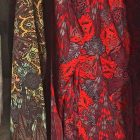Fashion news, content, editorial proposals and vision.
“Prints are like a story in permanent construction: they are constantly re-elaborated but they never disappear. What’s important here is to know how to adapt them and to conduct its evolution into each business plan over time.”
L’Officiel Mexico, Mexican edition of the prestigious French magazine which has almost a century of publications, launched in March, 2014, covers current topics of luxury, fashion news, art, culture and lifestyle. What role does Pamela Ocampo play in this scenario? After working at public relations for Elle Magazine, Mexico -and with the conviction that her destiny was to be a part of the editing, publishing, or the fashion news department-, she took the position of styling coordinator of the magazine, position she held for 7 years.
“At that time when I had a direct relationship with fashion and digital communications had not reached the development they have now. Throughout time, there has been an exceptional growth and deployment in the publishing industry and a remarkable interest in terms of fashion news, luxury and lifestyle in Mexico.”
Today, she’s editor in chief of L’Officiel Magazine; along with her team, she’s in charge of the final product that we all see in fashion news’ social networks and, of the issue we buy in magazine stands. She also sets the tone and editorial direction for the publication, which thrives to achieve the expression of the company’s point of view.
”In terms of local fashion over the past 10 years, Mexico has become a creative center during this past decade. With the help of Instagram and other advances in social networks dedicated to fashion news, our Fashion Week has established as a household name and has gained a lot of strength. In many ways, you can perceive the drive to make fashion and create more platforms”.
As for influencers and bloggers…
“We are currently living in a society where everyone wants to be multitasking, in which the importance of generating content, having a solid foundation and offering a clear editorial point of view is left behind more often than not. People should become more aware of what is true and what is fake within fashion news and within a global industry.”
“The important thing to be a successful entrepreneur is the essence and passion with which things start, and to be very true to what you really are.”
Media networks have been claiming for a while now, that the printing magazine industry is in decline and that printed media is outdated. Linda Thomas Brooks, president and CEO of the Magazine Media Association, or MPA, argues that “printed media is one of the most effective ways to deeply engage consumers, build brand awareness and sell products.”
“The digital revolution made it easier than ever for brands to market directly to consumers, so in the past several years, investment in advertising has gone toward direct marketing tactics. When consumers want to understand a specific topic or feel inspired by something, printed magazines are the preferred format for all age groups, including millenials. Printed magazines are a deeper reading experience … they are read in much slower pace, they are more focused and attentive, and, as a result, they have a greater understanding and remembrance of brand messages.”
When we ask her about yesterday and today’s influence of printed editorials, Pamela emphasizes on the importance of having a consistent presence on the digital industry because that’s the place where people are spending much of their daily time: “in the past, the printed business was stronger than today, from my point of view, printed media are one the many legacies of what we’re currently living.’’
“One thing that has always been quite interesting to me is that in museums and art exhibitions there are always printed magazines about the artist. It is a melancholic and romantic source of information and inspiration: it is part of what we are as a society, a reflection of the moment we are living, what we eat, fashion news, what we see and hear, and, above all, it reflects what touches our feelings. Everything comes back, always: it’s cyclical and it’s a matter of fashion.”
Regarding brands that Pamela consider to have excellent communication skills, she admits that they are too many, but that the first one that pops into her mind is Gucci, because of the great contrast and logic campaign alignment that the brand has had now and then in the hands of Alessandro Michele; she highlights its consistency and punctuality. Chanel and Louis Vuitton come in the expert zone.
In the new talent side, the Mexican brand Yakampot is her favorite at the time: “it reflects the essence of what contemporary Mexican luxury is in its entirety through its campaigns, through the embellishment in garments and collections and in the way those are presented to the market.”
“For me, the importance of communication groups of fashion brands is to work hand in hand with the design group to get the vision to completion from the beginning to the end.”
When asked about her professional opinion regarding Colombia’s fashion global position from her Mexican perspective, she immediately laughs and exclaims: Colombia has a lot of flavor!
Where does this flavor come from? Pamela, fashion news expertise, states that the Latin style is a key tool in the country’s fashion industry: the way it is fostered and boosted through its diverse color palettes and the authenticity allows achieving incredible elegance and sophistication.
She point out the importance of the heritage of traditional carnival costumes; they have served as inspiration for designers like Pepa Pombo and Johanna Ortiz in terms of their vision and identity.
Your advice for growing fashion industries?
“Support and consume local talent by valuing the quality and process behind each statement.”






What do you think?